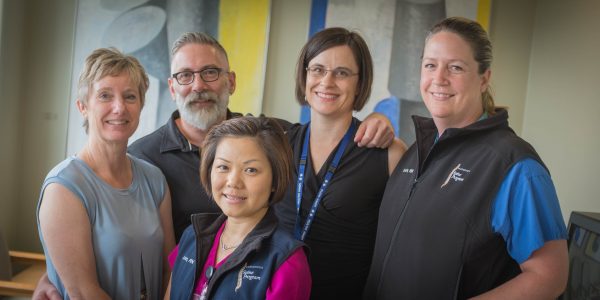Spine team puts pressure on ulcer care
The management of pressure ulcers is a key part of the required organizational practice (ROP) for skin care, and just one of the things Accreditation Canada surveyors will be looking at this September when they visit VCH.
To maximize patient outcomes, and with an eye towards the upcoming accreditation process, the VGH Acute Spine Unit team developed a new pressure ulcer prevention protocol and evaluated how they provided skin care to patients with a new spinal cord injury.
Multidisciplinary approach
VCH has a standard Pressure Injury Prevention strategy that Vancouver Acute is currently implementing. As part of implementation each team decides on what their interdisciplinary approach will be to ensure processes are sustainable over the long term.
In the Spine Team’s program, occupational therapists were responsible to: check skin, determine pressure ulcer development risk, and recommend therapeutic interventions including mattress selection. Nurses provided daily skin care including daily washes, skin checks, regular turning in bed and wound care. The dietitian maintained nutritional status and received updates from the OTs regarding patients at risk, and the nurse educator provided specific bedside wound management education when a patient at risk of or with a pressure ulcer was identified.
“It takes a whole multidisciplinary team to do this kind of work,” said John Cobb, occupational therapist with the Spine Unit and one of the authors of the study.
The proof is in the PUPI
A study was conducted in partnership with the Rick Hansen Institute following the development of the Pressure Ulcer Prevention Initiative (PUPI) to evaluate the protocol. The study showed that a more rigorous process to address pressure ulcer prevention was achieved. More disciplines were involved than previously, assessment and intervention was better aligned to professional experience and the team was able to establish a baseline (ie. pressure ulcer incidence) and are now in a position to continue developing and refining practices to ‘move the goal post’ towards better and better patient outcomes.
More about Accreditation 2016
• Learn more about VCH Accreditation 2016 at: vchconnect/accreditation
• Watch the VIDEO: Accreditation-It’s what we do every day.
About the study
Evaluation of a pilot Pressure Ulcer Prevention Initiative (PUPI) for patients with traumatic spinal cord injury admitted to an acute care setting
1John E. Cobb, OT ; 1Lise M.A. Bélanger, RN MSN ; 2,3So Eyun Park, BLMSc; 3Tian Shen, MSc; 3Carly S. Rivers, PhD; 2Marcel F. Dvorak, M.D.; 2John T. Street, M.D.; 2,3Vanessa K. Noonan, Ph.D. PT
1Vancouver General Hospital, Vancouver, Canada; 2Division of Spine, Department of Orthopedics, University of British Columbia, Vancouver, Canada; 3Rick Hansen Institute, Vancouver, Canada
Link to on-line abstract: http://www.ncbi.nlm.nih.gov/pubmed/24810305


